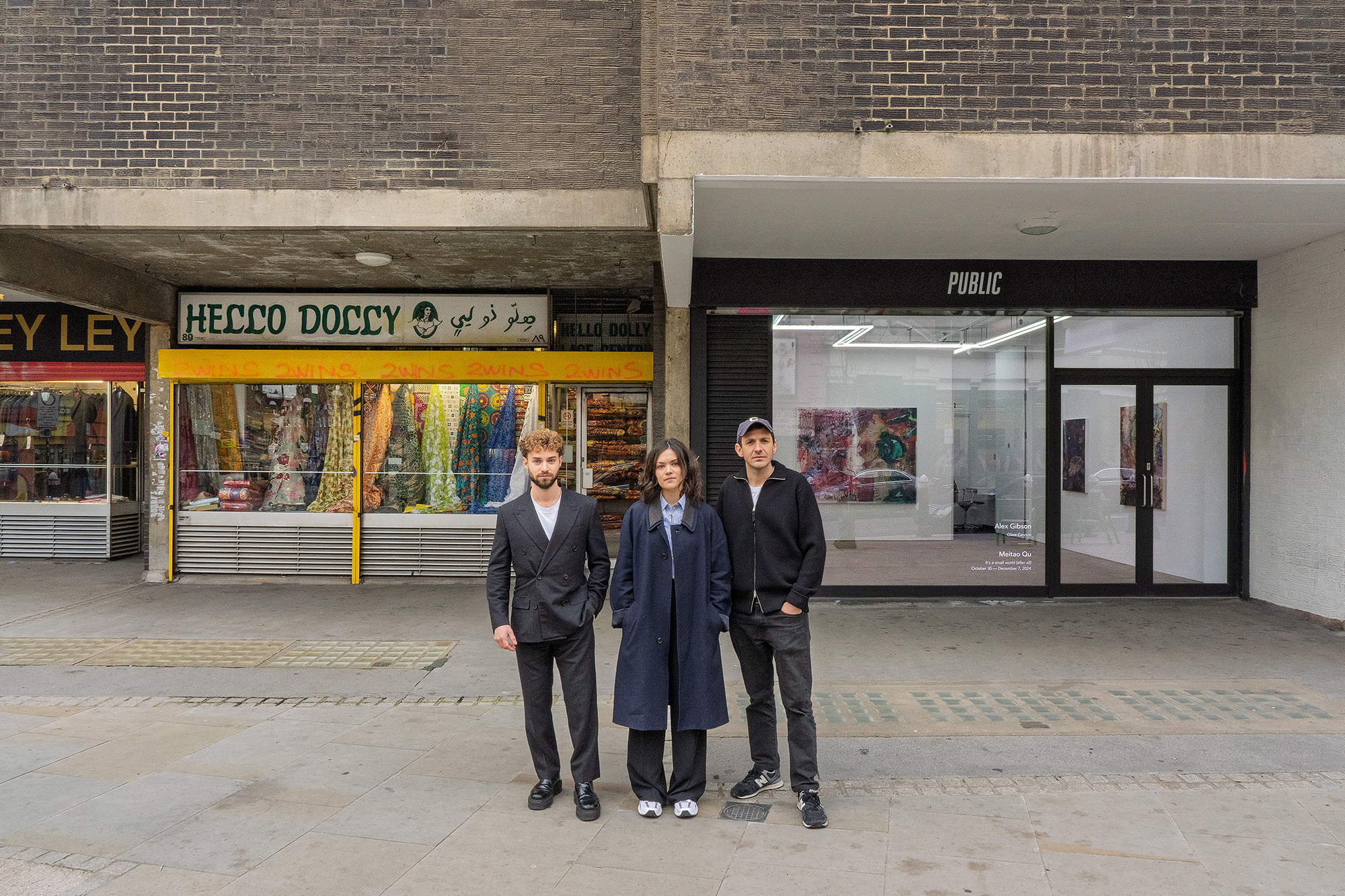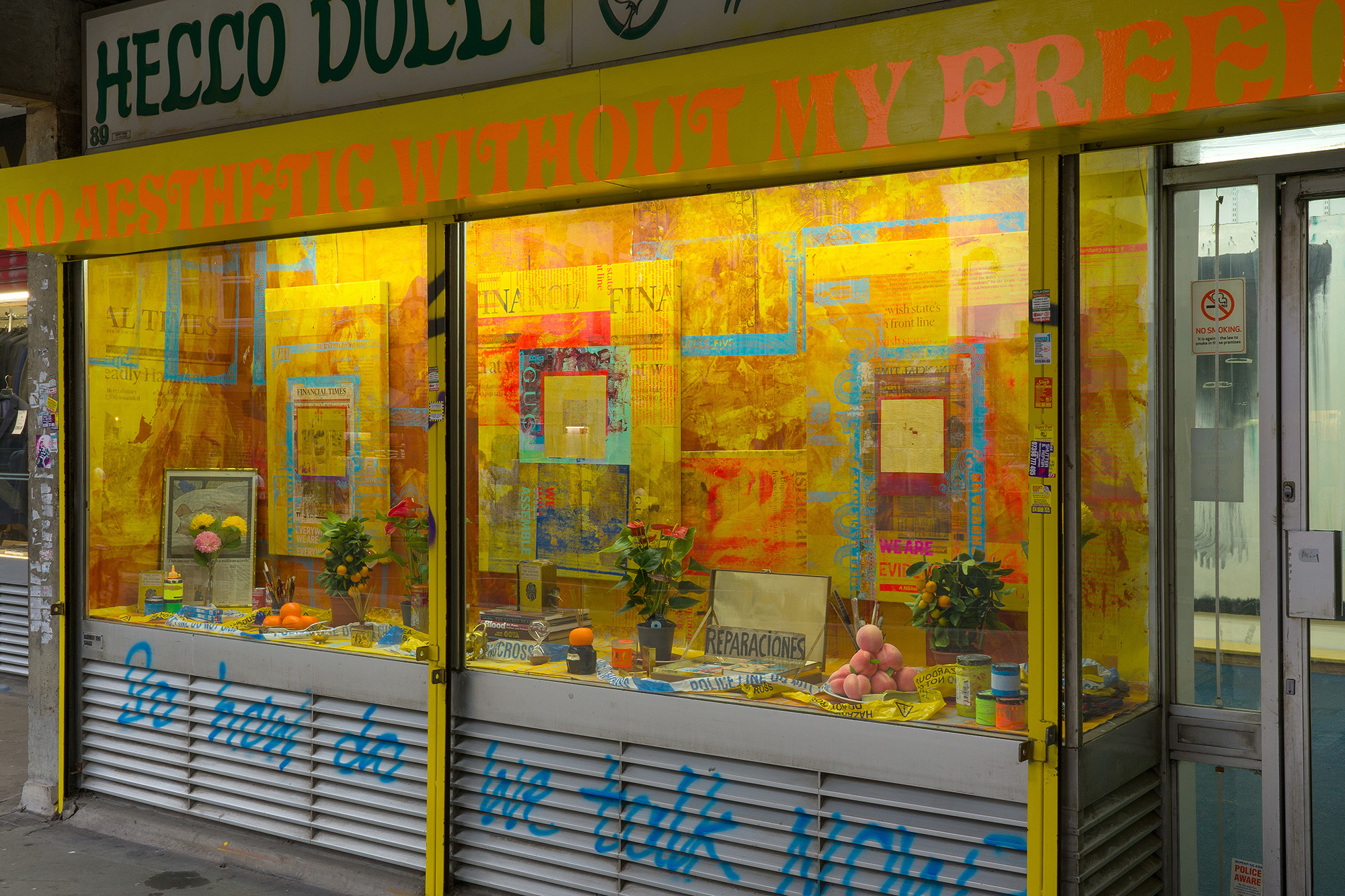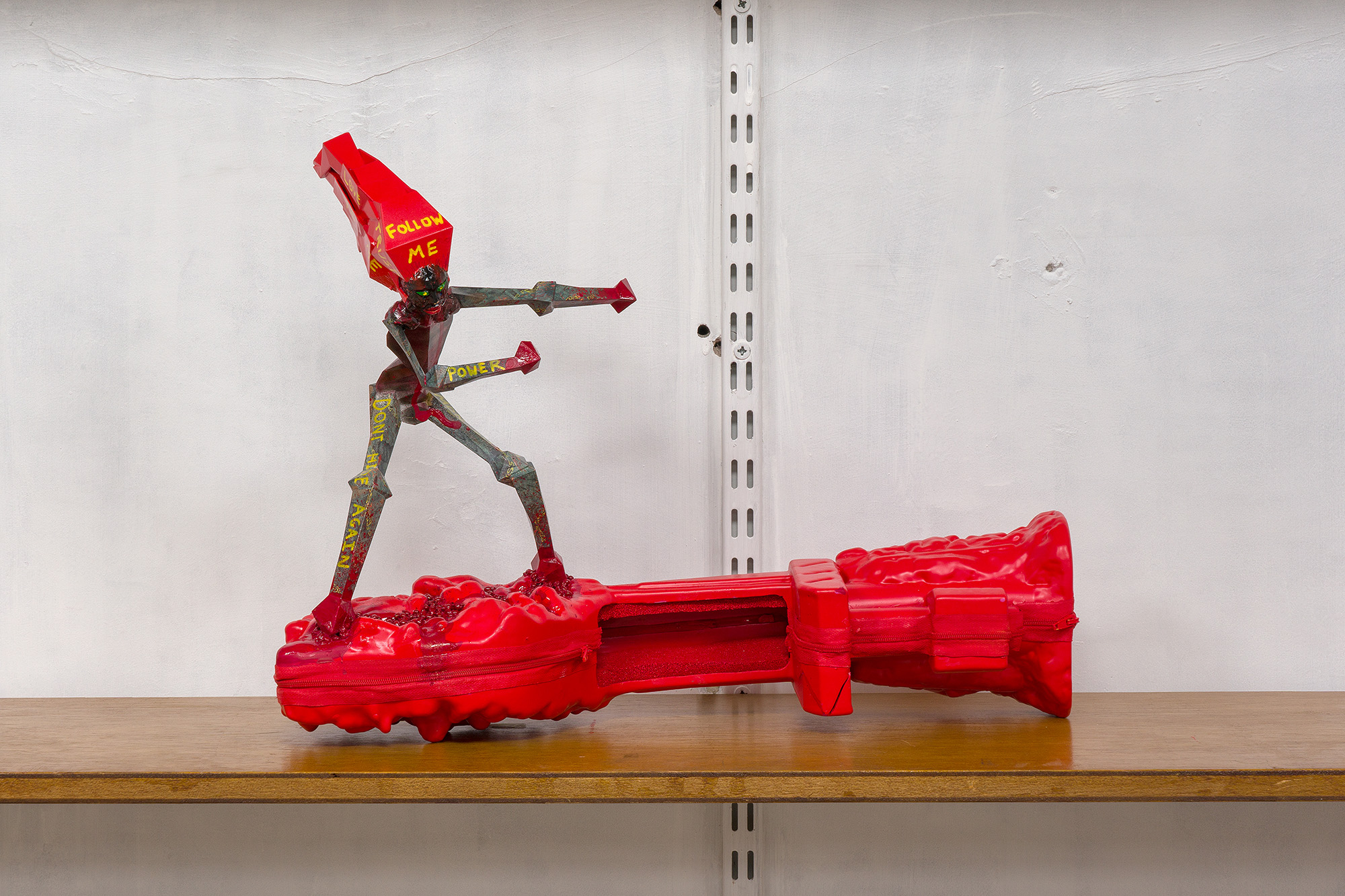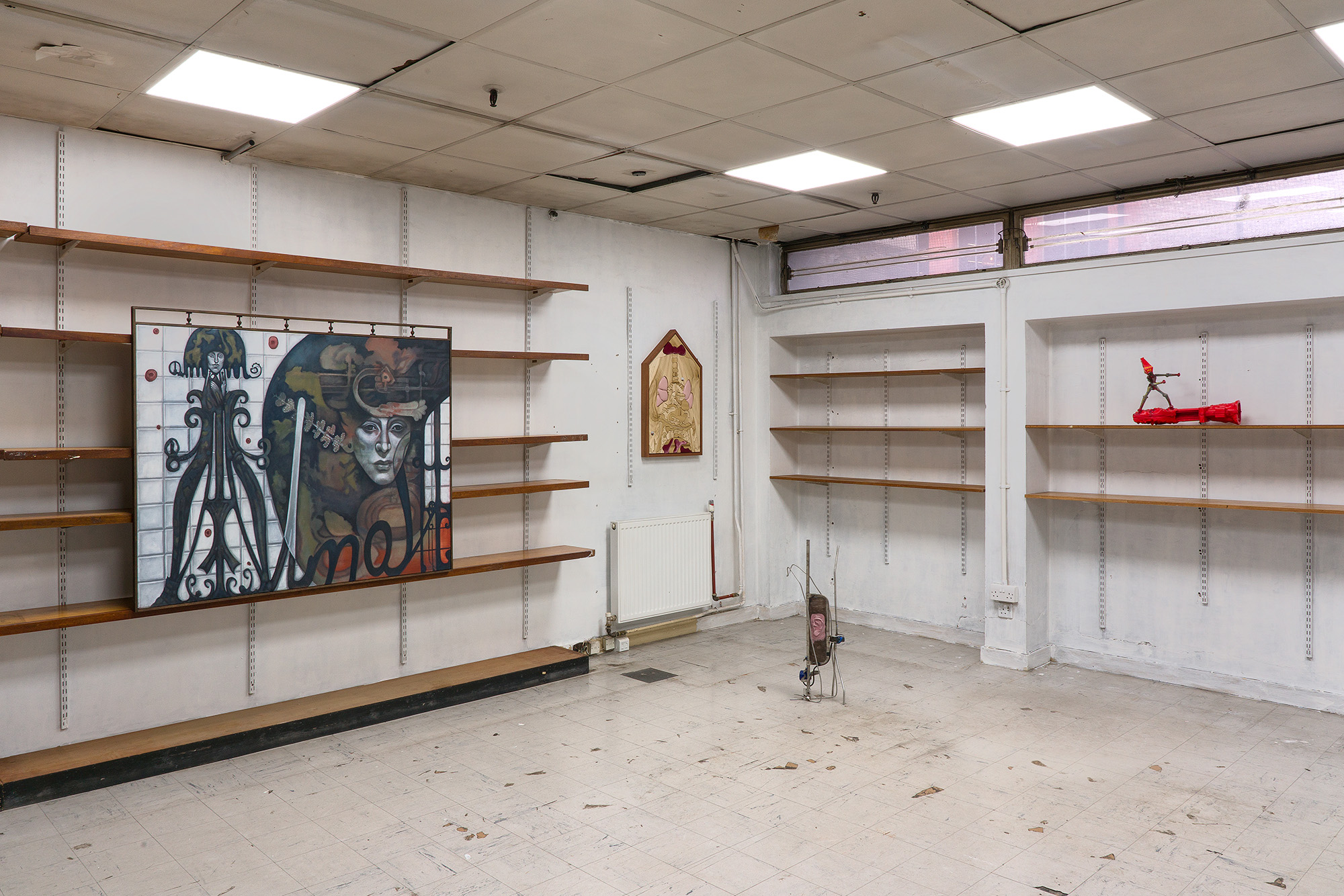Public Gallery’s new expansion celebrates the architectural fabric
of Spitalfields
A young art space in London’s Spitalfields, Public Gallery,
has taken over a neighbouring space and nearly doubled its exhibition space. Instead
of stripping the new building back and creating stark white walls, the patina
& feel of four decades of use as a fabric shop is being retained to create unique
exhibition rooms & it’s all being celebrated with a large new group show
& three exhibitions in partnership with Condo London
A stepped row of shops run along the ground level of
Petticoat Square, a social housing estate built in the late 1960s in the City
of London. Designed by Edwin George Chandler, architectural historian Nikolaus Pevsner described
the estate as “very hard and very urban, even by the standards of the time.”
Such hardness, however, softens through the patina of decades of existence, the
diverse communities that form and call the place home, and through the use and
decoration of the premises, especially along the street fronts of the shops
sitting slightly back from the road allowing overhung shelter and enlarged
pedestrian realm.
![]()
Several of the units are occupied by fabric wholesalers, lace, and textile shops with colourful, hanging displays packing the windows. It speaks to the cultural make up and history of the Spitalfields area, with silk, cloth, lace, and fabric passing through Huguenot, Jewish, Bangladeshi, and African communities since the 1600s. A mix of commercial and social functions fill the other units – watch repairer, wellbeing hub, tailor, coffee shop – and on Sundays the commercial busyness and urban visual noise grows with the energy of Petticoat Lane market. In the centre of all this is Public Gallery, a contemporary art space founded in 2020 by Alex Harrison and Harry Dougall.
Since then, it has delivered a packed schedule of over 30 solo and group exhibitions across three small gallery spaces over the three floors of the commercial unit. Abstracted architectural sculptures from New York-based artist Greg Carideo currently sit in the ground floor space. A solo presentation of his works, groundwork, considers forgotten and ignored thresholds and materials, creating uncanny assemblages which don’t seek to replicate or recreate the facades, doorways, openings, and awnings he draws inspiration from, so much as create carefully chaotic mashups of such architectural moments.
![]()
The works are of a curious scale – too large to appear as architectural models, but too small to appear as found objects from real world streetscapes. Instead, they occupy their own existence, reminding of and connecting to the variety of locations Carideo finds his materials – from a Sicilian beach to New Mexico desert, as well as New York sidewalks – as nonplace portals that speak to global experiences of incidental urban moments.
Just as Spitalfield is rooted in the rag trade and reuse of textile castoffs, so too Carideo utilises found fabrics in his works. The ripped awnings, patchworked surfaces, and hung curtains of the sculptures are formed of decayed and ripped t-shirts, pillowcases, and assorted pieces of clothing the artist found – he also repeatedly finds abandoned shoe heels in the street, which also find their way into the works. There is something fitting in this association of lost, forgotten, and mislaid items reformed into these incidental enclosures and thresholds. The ramshackle awnings, openings, and spaces speak to momentary places of safety and shelter for any person in any city
![]()
Since founding in 2020, Public Gallery have taken on a third Director, Nicole Estilo Kaiser, joining Harrison and Dougall in the management of the gallery, its busy schedule, and public programme. The three are now firmly rooted in the local community ecosystem, whether that be the artworld network – nearby galleries include Raven Row, Emalin, Whitechapel Art Gallery, Yamamoto Keiko Rochaix, Union Pacific – or the wider local neighbourhood – meetings are often held in the neighbouring coffee shop, while residents of the estate are regulars at exhibition openings and events.
Their name even derives from such a desire to connect beyond the normal art ecosystem. Kaiser says that many people outside the artworld are unaware that commercial galleries are, like any other shop, totally free to pop in and peruse. With the general public perhaps aware that museums and institutional galleries are places they can go and see culture for free, they may be less aware of the wealth of art within the commercial art scene – and so by overtly naming it Public Gallery it was hoped to be a clear invite to any passing person who may be interested.
This spirit of sharing continues with exhibitions held in the other two floors of Public Gallery, currently donated to two international galleries as part of the annual Condo London – a collaborative exhibition by 49 galleries across 22 London spaces that runs through to 15 February and has been running since 2016. The Greg Carideo presentation is part of the gallery’s Condo offer, with the basement space occupied by The Breeder, a gallery from Athens, while Martins & Montero, who have spaces in both São Paulo and Brussels, borrow the first floor.
![]()
For The Breeder, Kyriaki Goni present a video work taking up an entire wall of the gallery’s dark lower space – an artist we recently featured as part of Middlsborough Art Week (see 00228). Goni is interested in technological themes that are beginning to impact people’s everyday existence: surveillance, extractivism, intersection with politics. The work here, Not Allowed for Algorithmic Audiences, introduces us to Voice, a fictional AI avatar that starts to glitch, exuding vast amounts of recorded information it has scraped from the internet before its patent expires. It’s a piece that springboards from the artist’s observation of enormous, growing datasets trained on the human voice, not only from the 3.7m YouTube uploads a day but also smartphone and smart speaker recordings that are saturating our lives.
Ana Mazzei and Rebecca Sharp are both artists from São Paulo, presenting together for Martins & Montero. Mazzei creates wooden sculptures, mixing figurative and natural forms into arrangements partly informed from Brazil’s modernist history, landscapes, architecture, and archives. Sharp’s paintings also speak to ideas of abstracted landscape and forms combining the natural with ideas of the manmade – though with a surrealist twist. The works can read as a stage set pregnant for unknown, unexpected activities, perhaps speaking to the artist’s academic history studying theatre and dramatic arts at Goldsmiths and an MA in Buddhist and Asian philosophy.
![]()
Since Public Gallery opened, the neighbouring unit had been occupied by Vogue Fabrics, a textile shop. Recently, sadly – and not unusual in London’s increasingly expensive climate – the owner decided to close up shop and retire having been in operation for four decades – though faced with some time remaining on his lease, he found himself with an expensive predicament. The Public Gallery team had always got on well with their neighbour, and had been contemplating how they may expand as a gallery without relocating – and so there was a solution for all with the gallery taking over the fabric shop’s lease. Now, the young gallery have nearly doubled in size, taking over the former fabric shop to offer two new spaces, though with an aesthetic and frontage somewhat different to their main gallery space next door.
The new space opens with a group exhibition, 00:00:01, so titled to conjure the feeling of restarting, starting something afresh, or recalibrating to a new beginning. Where the three floors of their main galleries offer two classic white-walled, brightly lit rooms and a darker basement for video and immersive projects, the new unit has retained the patina and essence of its lifetime as a loved and busy shop. Timber shelving has largely been left in place, and where it has been temporarily removed on the first floor the marks and scratches on the wall behind leave a ghostly presence of the trade and life that went before.
![]()
![]()
There are quirks to the space that give it real character, with the gallery looking to only slowly change the space and over time allow it to reshape as needed while leaving as much of the personality and architectural fabric as possible. The linoleum floors, shelving, and ramshackle ceiling tiles have all been left with the only noticeable addition being bright white lighting, shedding a new glow on everyday heritage now revealed. At ground level, a box-like vitrine window offers the gallery a unique display case, with the work of Mandy El-Sayegh as its first offer in a poetic play with the unit’s former use as well as window displays of other shops along the street.
El-Sayegh, from Malaysia, creates screen printed and painted loose canvases which are then layered into the vitrine to create a collage of not only colour and material, but also of political stories, images, and headlines that are compressed into the bright compositions. The artist starts her canvases like this before, as a second process, selecting some to be stretched and framed and further developed. Three of these are hung neatly over the montaged fabrics, in front is an arrangement of found objects, ephemera, and organic matter.
![]()
Above, a new faux-shop sign carries the words “no aesthetic without my freedom” (Vogue Fabrics’ previous signage with the phrase “Hello Dolly” is still visible, left in situ behind) while beneath, over ventilation grates, is the graffiti phrase “so, how do we talk now?” The newsprint within works speaks of the crises across the world, including in Gaza, and the whole composition speaks to the artist’s interest in trying to better understand social and political processes and phenomena seemingly larger than our minds may easily rationalise.
![]()
![]()
El-Sayegh is one of 17 artist in 00:00:01, an exhibition crammed into the two floors of the new space but which utilises the shelving of the former textile selling occupier through smaller-scale sculptures that some of the exhibiting artists are presenting. This includes the first sculpture from Danielle Brathwaite-Shirley, an artist more well-known for large-scale installations utilising glitchy video game technology in immersive, provocative explorations of black trans existence (see 00078) who here has cast a small hand-painted sculpture of one her digital avatars.
![]()
![]()
![]()
![]()
![]()
Other artists include: Steph Huang who continues from a recent solo presentation at Tate Britain conceptually considering mass production in the food industry with a cyborg sculpture of a creature and spam tins; Rose Nestler’s weird, child-toy-like wooden jigsaw of human innards; a checkerboard Igshaan Adams weaving smaller though no less intricate than the vast works recently on show at Hepworth Wakefield; and a concrete sculpture from Ignacia Gatica, representing copy of Enjoyment of Laughter, a 1930s book by radical an writer Max Eastman looking at the science of humour – though Gatica has punctured a hole through the tome.
Having doubled in size and opening 2025 with four concurrent exhibitions, the small team at Public Gallery are busy. Yet, the space does not shout its presence, and there seems less ego and try-hard attitude at play than in some galleries emerging into a busy scene, and it seems all the more powerful for it. The two buildings it occupies speak to this more gentle, considered way of being – comfortably positioned in the post-war architecture, working with the nearby community, and not pushing to present loudly, aggressively, or against the feel and fabric of the street. The new space continues this approach, with such a gentle intervention that it may not even register as a space of contemporary art to many walking along the pavement past it and its many neighbouring textile shops. And that may be a very good way for contemporary art to exist in such a mixed public community.
![]()
![]()
![]()

Several of the units are occupied by fabric wholesalers, lace, and textile shops with colourful, hanging displays packing the windows. It speaks to the cultural make up and history of the Spitalfields area, with silk, cloth, lace, and fabric passing through Huguenot, Jewish, Bangladeshi, and African communities since the 1600s. A mix of commercial and social functions fill the other units – watch repairer, wellbeing hub, tailor, coffee shop – and on Sundays the commercial busyness and urban visual noise grows with the energy of Petticoat Lane market. In the centre of all this is Public Gallery, a contemporary art space founded in 2020 by Alex Harrison and Harry Dougall.
Since then, it has delivered a packed schedule of over 30 solo and group exhibitions across three small gallery spaces over the three floors of the commercial unit. Abstracted architectural sculptures from New York-based artist Greg Carideo currently sit in the ground floor space. A solo presentation of his works, groundwork, considers forgotten and ignored thresholds and materials, creating uncanny assemblages which don’t seek to replicate or recreate the facades, doorways, openings, and awnings he draws inspiration from, so much as create carefully chaotic mashups of such architectural moments.

The works are of a curious scale – too large to appear as architectural models, but too small to appear as found objects from real world streetscapes. Instead, they occupy their own existence, reminding of and connecting to the variety of locations Carideo finds his materials – from a Sicilian beach to New Mexico desert, as well as New York sidewalks – as nonplace portals that speak to global experiences of incidental urban moments.
Just as Spitalfield is rooted in the rag trade and reuse of textile castoffs, so too Carideo utilises found fabrics in his works. The ripped awnings, patchworked surfaces, and hung curtains of the sculptures are formed of decayed and ripped t-shirts, pillowcases, and assorted pieces of clothing the artist found – he also repeatedly finds abandoned shoe heels in the street, which also find their way into the works. There is something fitting in this association of lost, forgotten, and mislaid items reformed into these incidental enclosures and thresholds. The ramshackle awnings, openings, and spaces speak to momentary places of safety and shelter for any person in any city

Since founding in 2020, Public Gallery have taken on a third Director, Nicole Estilo Kaiser, joining Harrison and Dougall in the management of the gallery, its busy schedule, and public programme. The three are now firmly rooted in the local community ecosystem, whether that be the artworld network – nearby galleries include Raven Row, Emalin, Whitechapel Art Gallery, Yamamoto Keiko Rochaix, Union Pacific – or the wider local neighbourhood – meetings are often held in the neighbouring coffee shop, while residents of the estate are regulars at exhibition openings and events.
Their name even derives from such a desire to connect beyond the normal art ecosystem. Kaiser says that many people outside the artworld are unaware that commercial galleries are, like any other shop, totally free to pop in and peruse. With the general public perhaps aware that museums and institutional galleries are places they can go and see culture for free, they may be less aware of the wealth of art within the commercial art scene – and so by overtly naming it Public Gallery it was hoped to be a clear invite to any passing person who may be interested.
This spirit of sharing continues with exhibitions held in the other two floors of Public Gallery, currently donated to two international galleries as part of the annual Condo London – a collaborative exhibition by 49 galleries across 22 London spaces that runs through to 15 February and has been running since 2016. The Greg Carideo presentation is part of the gallery’s Condo offer, with the basement space occupied by The Breeder, a gallery from Athens, while Martins & Montero, who have spaces in both São Paulo and Brussels, borrow the first floor.

For The Breeder, Kyriaki Goni present a video work taking up an entire wall of the gallery’s dark lower space – an artist we recently featured as part of Middlsborough Art Week (see 00228). Goni is interested in technological themes that are beginning to impact people’s everyday existence: surveillance, extractivism, intersection with politics. The work here, Not Allowed for Algorithmic Audiences, introduces us to Voice, a fictional AI avatar that starts to glitch, exuding vast amounts of recorded information it has scraped from the internet before its patent expires. It’s a piece that springboards from the artist’s observation of enormous, growing datasets trained on the human voice, not only from the 3.7m YouTube uploads a day but also smartphone and smart speaker recordings that are saturating our lives.
Ana Mazzei and Rebecca Sharp are both artists from São Paulo, presenting together for Martins & Montero. Mazzei creates wooden sculptures, mixing figurative and natural forms into arrangements partly informed from Brazil’s modernist history, landscapes, architecture, and archives. Sharp’s paintings also speak to ideas of abstracted landscape and forms combining the natural with ideas of the manmade – though with a surrealist twist. The works can read as a stage set pregnant for unknown, unexpected activities, perhaps speaking to the artist’s academic history studying theatre and dramatic arts at Goldsmiths and an MA in Buddhist and Asian philosophy.

Since Public Gallery opened, the neighbouring unit had been occupied by Vogue Fabrics, a textile shop. Recently, sadly – and not unusual in London’s increasingly expensive climate – the owner decided to close up shop and retire having been in operation for four decades – though faced with some time remaining on his lease, he found himself with an expensive predicament. The Public Gallery team had always got on well with their neighbour, and had been contemplating how they may expand as a gallery without relocating – and so there was a solution for all with the gallery taking over the fabric shop’s lease. Now, the young gallery have nearly doubled in size, taking over the former fabric shop to offer two new spaces, though with an aesthetic and frontage somewhat different to their main gallery space next door.
The new space opens with a group exhibition, 00:00:01, so titled to conjure the feeling of restarting, starting something afresh, or recalibrating to a new beginning. Where the three floors of their main galleries offer two classic white-walled, brightly lit rooms and a darker basement for video and immersive projects, the new unit has retained the patina and essence of its lifetime as a loved and busy shop. Timber shelving has largely been left in place, and where it has been temporarily removed on the first floor the marks and scratches on the wall behind leave a ghostly presence of the trade and life that went before.


There are quirks to the space that give it real character, with the gallery looking to only slowly change the space and over time allow it to reshape as needed while leaving as much of the personality and architectural fabric as possible. The linoleum floors, shelving, and ramshackle ceiling tiles have all been left with the only noticeable addition being bright white lighting, shedding a new glow on everyday heritage now revealed. At ground level, a box-like vitrine window offers the gallery a unique display case, with the work of Mandy El-Sayegh as its first offer in a poetic play with the unit’s former use as well as window displays of other shops along the street.
El-Sayegh, from Malaysia, creates screen printed and painted loose canvases which are then layered into the vitrine to create a collage of not only colour and material, but also of political stories, images, and headlines that are compressed into the bright compositions. The artist starts her canvases like this before, as a second process, selecting some to be stretched and framed and further developed. Three of these are hung neatly over the montaged fabrics, in front is an arrangement of found objects, ephemera, and organic matter.

Above, a new faux-shop sign carries the words “no aesthetic without my freedom” (Vogue Fabrics’ previous signage with the phrase “Hello Dolly” is still visible, left in situ behind) while beneath, over ventilation grates, is the graffiti phrase “so, how do we talk now?” The newsprint within works speaks of the crises across the world, including in Gaza, and the whole composition speaks to the artist’s interest in trying to better understand social and political processes and phenomena seemingly larger than our minds may easily rationalise.


El-Sayegh is one of 17 artist in 00:00:01, an exhibition crammed into the two floors of the new space but which utilises the shelving of the former textile selling occupier through smaller-scale sculptures that some of the exhibiting artists are presenting. This includes the first sculpture from Danielle Brathwaite-Shirley, an artist more well-known for large-scale installations utilising glitchy video game technology in immersive, provocative explorations of black trans existence (see 00078) who here has cast a small hand-painted sculpture of one her digital avatars.





Other artists include: Steph Huang who continues from a recent solo presentation at Tate Britain conceptually considering mass production in the food industry with a cyborg sculpture of a creature and spam tins; Rose Nestler’s weird, child-toy-like wooden jigsaw of human innards; a checkerboard Igshaan Adams weaving smaller though no less intricate than the vast works recently on show at Hepworth Wakefield; and a concrete sculpture from Ignacia Gatica, representing copy of Enjoyment of Laughter, a 1930s book by radical an writer Max Eastman looking at the science of humour – though Gatica has punctured a hole through the tome.
Having doubled in size and opening 2025 with four concurrent exhibitions, the small team at Public Gallery are busy. Yet, the space does not shout its presence, and there seems less ego and try-hard attitude at play than in some galleries emerging into a busy scene, and it seems all the more powerful for it. The two buildings it occupies speak to this more gentle, considered way of being – comfortably positioned in the post-war architecture, working with the nearby community, and not pushing to present loudly, aggressively, or against the feel and fabric of the street. The new space continues this approach, with such a gentle intervention that it may not even register as a space of contemporary art to many walking along the pavement past it and its many neighbouring textile shops. And that may be a very good way for contemporary art to exist in such a mixed public community.



Public Gallery is a London-based contemporary art gallery dedicated to supporting international emerging artists and promoting cross-cultural exchange. The gallery was founded in 2020 and cultivates a diverse curatorial programme presenting work in all media across its three story brutalist East London space, encouraging ambitious projects, intergenerational dialogues, and non-traditional modes of seeing and thinking. Public is led by Founding Directors Alex Harrison and Harry Dougall and Director Nicole Estilo Kaiser.
www.public.gallery
visit
Greg Carideo, groundwork, runs through to 15
February. Full details available at: www.public.gallery/exhibitions/groundwork
The hosting of The Breeder (Athens) & Martins &
Montero (São Paulo / Brussels) as part of Condo London continues to 15
February.
The group exhibition 00:00:01 also continues until 15
February, with details available at: www.public.gallery/exhibitions/00-00-01
Condo London 2025 runs through to 15 February, and full
details of participating galleries & artists can be found on the project’s
website: www.condocomplex.org
images
All photographs courtesy Public Gallery.
publication date
20 January 2025
tags
Igshaan Adams, Awning, Danielle Brathwaite-Shirley, Greg Carideo, Edwin George Chandler, Harry Dougall, Mandy El-Sayegh, Nicole Estilo Kaiser, Fabric, Ignacia Gatica, Kyriaki Goni, Alex Harrison, Housing estate, Steph Huang, Martins & Montero, Ana Mazzei, Rose Nestler, Public Gallery, Rebecca Sharp, Shop, Spitalfields, Textiles, The Breeder, Threshold, Vogue Fabrics
The hosting of The Breeder (Athens) & Martins & Montero (São Paulo / Brussels) as part of Condo London continues to 15 February.
The group exhibition 00:00:01 also continues until 15 February, with details available at: www.public.gallery/exhibitions/00-00-01
Condo London 2025 runs through to 15 February, and full details of participating galleries & artists can be found on the project’s website: www.condocomplex.org


